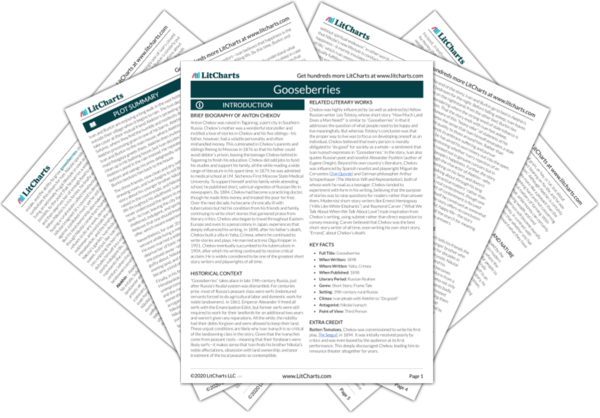Nikolai’s gooseberries represent the idea that people tend to delude themselves into happiness rather than accepting the truth. For over 20 years, Nikolai lives an extremely frugal lifestyle in order to save toward his ultimate dream of owning a country estate. During this time, the ability to grow and eat his own gooseberries is central to Nikolai’s vision of his ideal future. When he finally achieves his dream of owning land, and he and his brother Ivan eat the gooseberries from Nikolai’s own bushes, Nikolai relishes in how sweet and delicious they are—but Ivan finds them too “tough and sour” to eat.
Reflecting on Nikolai’s greedy enjoyment of the gooseberries, Ivan quotes writer Alexander Pushkin, who said, “Dearer to us than a host of truths is an exalting illusion.” In this case, the gooseberries represent the “exalting illusion” of Nikolai’s entire lifestyle: he appears wealthy, comfortable, and fulfilled, but Ivan believes that Nikolai’s happiness is actually rooted in self-delusion. In reality, Nikolai’s estate isn’t how he imagined it would be (it’s covered in dense brush and sits on a polluted river)—and Nikolai has become fat, lazy, and arrogant since becoming a landowner. Furthermore, he was only able to afford the land by living a miserly lifestyle for decades, sacrificing relationships and his own well-being to save as much money as possible.
The brothers’ opposite perceptions of how the gooseberries taste thus represent their opposite views of what makes life meaningful. Nikolai finds the gooseberries sweet, which parallels his rosy view of his own circumstances. Ivan, on the other hand, finds the gooseberries sour, which reflects his opinion that people like Nikolai deny the ugly truth of their lives to remain blissfully ignorant and convince themselves that they’re fulfilled. Of course, readers don’t know what the gooseberries actually taste like—it could be that Nikolai is indeed deluding himself into believing that they’re sweet. Or, it could be that the bitterness Ivan tastes is his own delusion, a reflection of his resentment toward Nikolai for achieving happiness in the countryside while Ivan himself remains miserable in the city. The gooseberries, then, symbolize all forms of the “exalting illusions” that dominate people’s lives.
Gooseberries Quotes in Gooseberries
“They were tough and sour, but as Pushkin said, ‘Dearer to us than a host of truths is an exalting illusion.’ I saw a happy man, whose cherished dream had so obviously come true, who had attained his goal in life, had gotten what he wanted, who was content with his fate and with himself. For some reason there had always been something sad mixed with my thoughts about human happiness, but now, at the sight of a happy man, I was overcome by an oppressive feeling close to despair.”
Ivan Ivanych’s story satisfied neither Burkin nor Alekhin. With the generals and ladies gazing from gilded frames, looking alive in the twilight, it was boring to hear a story about a wretched official who ate gooseberries. For some reason they would have preferred to speak and hear about fine people, about women. And the fact that they were sitting in a drawing room where everything—the covered chandelier, the armchairs, the carpets under their feet—said that here those very people now gazing from the frames had once walked, sat, drunk tea, and that the beautiful Pelageya now walked noiselessly here, was better than any story.

















